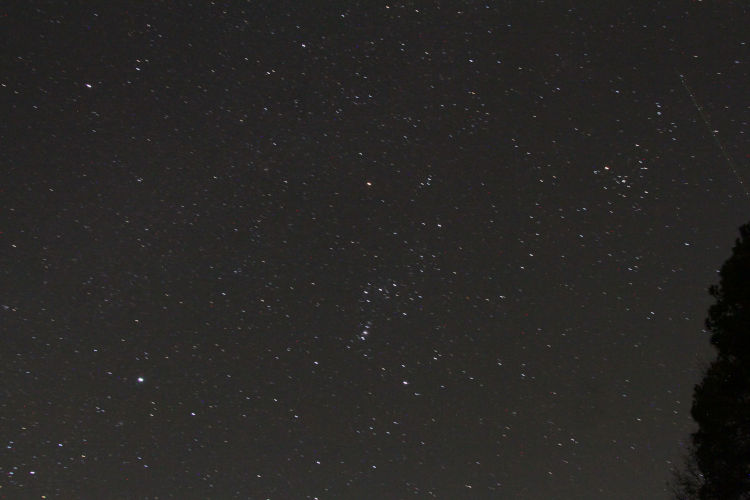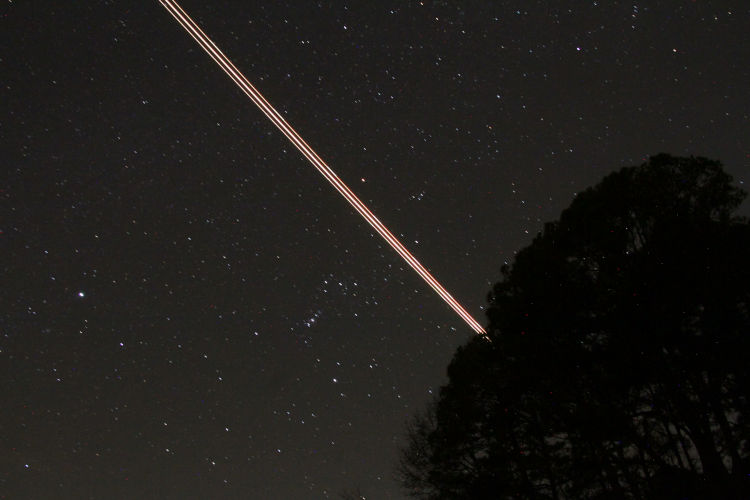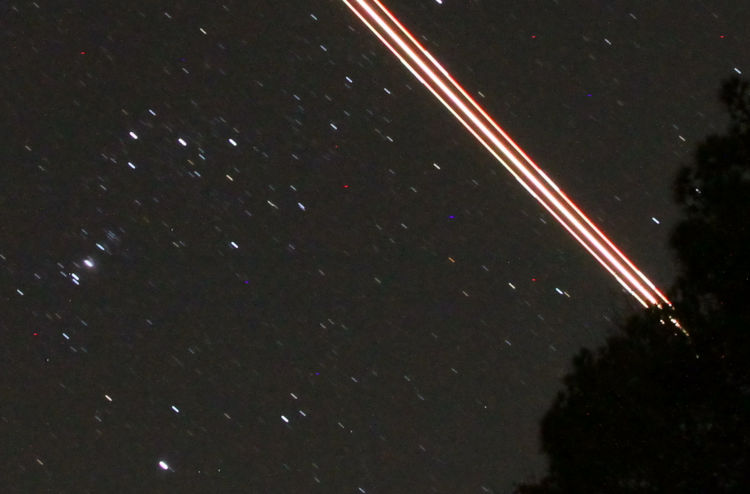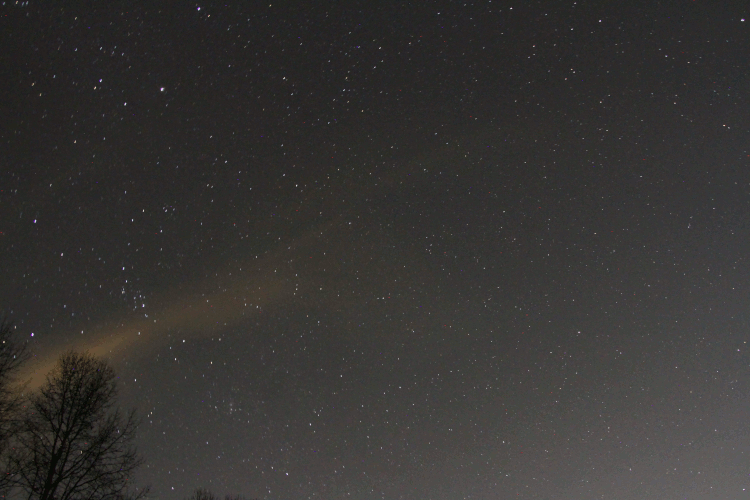
My calendar has been reminding me of the Geminids meteor shower for the past week or so, which was due to peak overnight last night, but the temperatures have dropped significantly for the past week as well. Since the Geminids are touted to be one of the better showers and we had nice clear skies, I finally got motivated to bundle up, go out, and try.
And indeed, it was a notably active shower, more so than I’ve seen since 2001, and I witnessed at least eight distinct meteors in the hour that I was out, probably more – I wasn’t counting. Don’t get excited about that one up there in the upper right corner, because that’s only a plane – you can see the strobe dots along it periodically. The truth is, I didn’t catch one, again – there’s no point in building suspense over that.
But the annoying part is, I saw at least two that should have easily been within the frame, and several more that might have made it in along the edges. Naturally, the most distinct meteors that I saw fell well outside the field of view of the camera, which is frustrating when you’re out there but, really, only to be expected; the camera can only see a small portion of the sky at once, so the odds work against you automatically. It is sorely tempting to say, Oh, shit, there was one over there! I’ll re-aim the camera to that point now that it’s already past, but it’s a fool’s game. One that I admit I played a couple times last night, too, when multiple meteors passed through the same region of sky and made me believe there was some sort of pattern occurring. There’s no reason that I know of that such a thing can happen during a shower, but honestly, it worked: I saw two that were right within the frame when I did this. Only, there’s not the slightest hint of them in the resulting images.

No, c’mon, you know that’s another plane, on approach to the nearby airport. I saw it coming well before it would have entered the frame, and fired off an exposure just for its own sake. Only, just after the plane had passed from the frame, I saw a meteor cut through immediately to the right of Orion, right beneath the plane’s path. Not bright or long, but distinct. Do you see it?
Do you see it now?

It was right there, but I can’t bring up even the faintest hint of it at all. The takeaway is, my settings were inadequate to capture something that dim, brief, and fast. These are roughly one-minute exposures at ISO 3200, f8, which I would have thought would be more than enough, and pushing it further would have started the sky glow taking over the frame and drowning out any hint of the dimmer meteors. However, you see the results, so I guess I’d better approach this differently next time. The one thing that I did accomplish last night/this morning was to know that my settings were wrong, because I know there were two in the frames. So, next time, it will probably be the f2.8 lens at ISO 6400, and only ten second exposures or something – testing this, of course, is a little difficult.
The funny thing is, I have captured some meteors previously in what I thought were much worse conditions, so I’m faintly confused.
But so it’s not a total loss, here’s an animated gif (pronounced, “git-OW-da-heer“) of eleven frames all aimed at one spot to the north-northwest.

I know one of these frames should have contained another meteor, pretty much right smack in the middle, but again, not the faintest sign. So the cloud movement is a nice touch if nothing else, and you can see the circular motion of the stars from aiming north; Polaris, the north star, is the brightest one at lower right. This region of sky, to my limited experience last night, saw the most meteors, with the region around Orion being the second-most. Curiously, nearly all of the ones that I saw were at less than 45° from the horizon, with nothing apparently crossing ‘overhead.’ I also tended to see them in ‘pairs,’ two appearing within seconds of each other with long stretches of nothing in between. Seriously, you could have chased plenty of different ‘patterns’ last night, most likely in vain since they were only coincidences and nothing more.
Meteor showers generally come from the Earth passing through the old trails of comets, encountering the dust emitted by such as they came close to the sun and became more active, so they are a pattern in and of themselves, and two more exist as well. Such showers get their names from the radiant, the area of the sky that most of the meteors appear to be emanating from (in this case a spot near the constellation Gemini,) and this is because that region is directly forward in regards to the Earth’s passage at that point, so you’re looking ‘straight ahead’ as the Earth enters the debris trail – in my experience, this doesn’t account for much because, again, big sky. The other pattern is that more appear after midnight, this due to the rotation of the Earth and that it’s now facing more ‘into the stream.’ But as for other patterns that might help explain or predict the timing and location, as noted above? Not to my knowledge, though it remains possible that certain densities of the dust and particles exist along the comet’s path due to how active it got and so on. Mostly, however, it’s just because we automatically seek patterns and so often find them when they don’t actually exist, and I can also vouch that it’s sorely tempting to engage in superstition too, willing a meteor to appear when you’re aimed at it or even just thinking, One more frame – I’m bound to get one this time. Our minds are weird like that.



















































